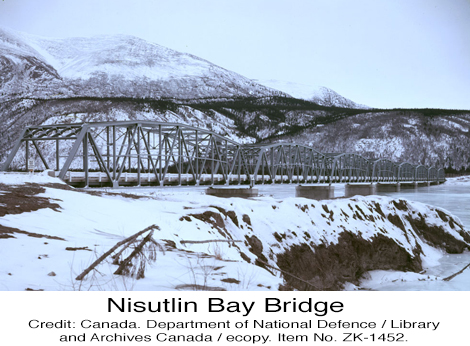Nisutlin Bay Bridge
The Nisutlin Bay Bridge crosses Teslin Lake, Yukon, at the narrowest point of the bay. This bridge, opened in spring 1956, should not be confused with the Teslin River Bridge, 2 km further north on the Alaska Highway.
The Nisutlin Bay Bridge has seven Warren through-truss spans, joined in a rhythmic design. It is the longest bridge on the Alaska Highway (584 m/1,917 feet), and is the third bridge to span this location at the edge of the town of Teslin since the highway was originally built.
This area is home to a First Nations group, the Inland Tlingit, who played an important role in the early development of this stretch of the highway. In the late 1930s, George Johnston, son of an Inland Tlingit chief, brought a car to Teslin. A good businessman, Johnston cut his own road 6 km (4 miles) along the lakeshore on which he ran a taxi service in the summer. In 1941, US Public Roads Administration (PRA) crews surveying the route for the Alaska Highway incorporated Johnston’s road into their plan.
Construction of the Alaska Highway attracted many Inland Tlingit to work as guides, packers and labourers, which had profound affects (both positive and negative) on their semi-nomadic way of life. For the first time, people stayed in the community over the winter instead of going out on their traplines. This made the community more vulnerable to the waves of infectious diseases (such as measles and meningitis) that swept through the village, killing a number of people. However, with more work in the community, the settlement slowly evolved into a town. It began to flourish with the addition of the tourist trade, and now offers its citizens medical, social and cultural services.

